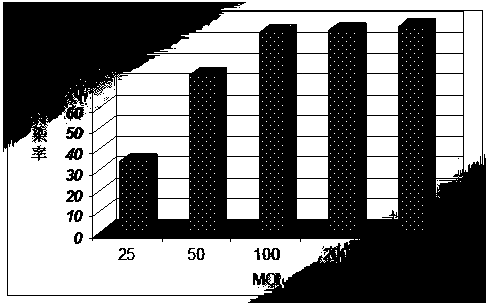Application of p53 gene in reversing the malignant characteristics of oral mucosal malignant melanoma cells and its in vitro evaluation method
A malignant melanoma, p53 gene technology, applied in the field of cell and molecular biology, can solve the problems of no gene therapy method, imperfect characterization method, immature technology, etc.
- Summary
- Abstract
- Description
- Claims
- Application Information
AI Technical Summary
Problems solved by technology
Method used
Image
Examples
Embodiment 1
[0047] Example 1 Passage and culture of human malignant melanoma cell line (A-375)
[0048] Take frozen A375 cells for recovery, add RPMI1640 (containing 10% calf serum) cell culture medium for culture, observe the cells, and passage when the culture bottle is 80% full.
[0049] figure 1 Photos of normal growth of A-375 cells entering the logarithmic growth phase under 100X and 200X microscopes. It can be seen from the figure that the cells grow well.
Embodiment 2
[0050] Example 2 Determination of the transfection efficiency of rAd-GFP to A-375
[0051] Take the A-375 cells recovered in Example 1, and use 1×10 5 The density of each well was inoculated in a 6-well culture plate for 24 hours after the cells adhered to the wall, the supernatant was sucked off, and the recombinant adenovirus (rAd-GFP) virus solution with the green fluorescent protein gene was used at MOI=0, 25, 50, 100, 200, 500 infected cells. After 48 hours, under a fluorescence microscope, randomly select three 200-field views in each well to count the number of GFP-positive cells showing green fluorescence, and at the same time count the total number of cells in the field of view under visible light, and calculate the transfection rate according to the formula (transfection rate r = number of GFP positive cells / total number of cells in the field of view).
[0052] The result is as figure 2 and image 3 As shown, 10-12 hours after transfection with Ad-GFP, A-375 cel...
Embodiment 3
[0053] Example 3 MTT method to detect the growth inhibition rate of A-375 cells under different rAd-p53 transfection intensities
[0054] Take the A-375 cells recovered in Example 1, and use 5×10 4 Inoculate each well in a 96-well plate, routinely culture for 24 hours after the cells adhere to the wall, absorb the culture medium, add recombinant human p53 adenovirus (rAd-p53) injection according to MOI=0, 25, 50, 100, 200, 500, Set rAd-p53 group and blank control group (only add complete culture medium), and set up three parallel wells for each concentration in each group.
[0055] MTT staining method was used to detect the growth inhibition rate of cells, and the optical density (OD) values at 24, 48, 72, 96, and 120 hours were measured with a porous high-efficiency analyzer at a wavelength of 570 nm, and the cell proliferation inhibition was calculated. Rate. Proliferation inhibition rate=(OD value of control group-OD value of treatment group) / OD value of control group×1...
PUM
 Login to View More
Login to View More Abstract
Description
Claims
Application Information
 Login to View More
Login to View More - R&D
- Intellectual Property
- Life Sciences
- Materials
- Tech Scout
- Unparalleled Data Quality
- Higher Quality Content
- 60% Fewer Hallucinations
Browse by: Latest US Patents, China's latest patents, Technical Efficacy Thesaurus, Application Domain, Technology Topic, Popular Technical Reports.
© 2025 PatSnap. All rights reserved.Legal|Privacy policy|Modern Slavery Act Transparency Statement|Sitemap|About US| Contact US: help@patsnap.com



